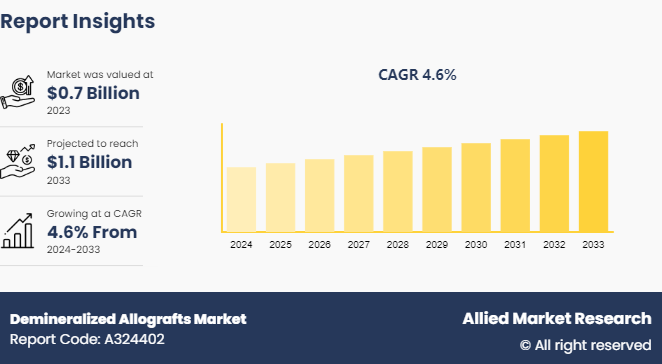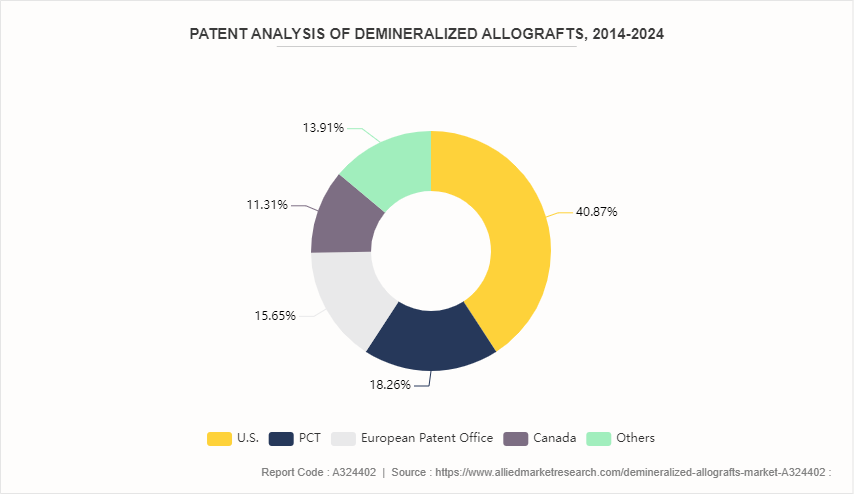Demineralized Allografts Market Research, 2033
The global demineralized allografts market was valued at $0.7 billion in 2023, and is projected to reach $1.1 billion by 2033, growing at a CAGR of 4.6% from 2024 to 2033. The increasing prevalence of orthopedic conditions like osteoarthritis, rheumatoid arthritis, and others is expected to drive the market growth of demineralized allograft.

Market Introduction and Definition
Demineralized allografts are bone grafts that have been processed to remove mineral content, typically calcium and phosphate. This process leaves behind the organic matrix of the bone, which includes growth factors and proteins that can promote bone healing and regeneration. The demineralization process involves treating the bone with acidic solutions to dissolve the mineral components while preserving the collagen matrix and other bioactive molecules. This makes the graft more conducive to bone formation when implanted. The increasing number of traffic accidents and joint problems, the need for dental bone grafts, and the aging population are the main reasons propelling the expansion of the market for demineralized allografts. Bone fractures and other accident-related injuries are frequently treated with graft. Furthermore, they can frequently be utilized to replace or repair damaged bone tissue, which aids in the restoration of normal function and movement.
Key Takeaways
The demineralized allografts market size covers 20 countries. The research includes a segment analysis of each country in terms of value ($Million) for the projected period 2024-2033.
More than 1, 500 product literatures, industry releases, annual reports, and other such documents of major demineralized allografts industry participants along with authentic industry journals, trade associations' releases, and government websites have been reviewed for generating high-value industry insights.
The study integrated high-quality data, professional opinions and analysis, and critical independent perspectives. The research approach is intended to provide a balanced view of global markets and to assist stakeholders in making educated decisions in order to achieve their most ambitious growth objectives.
Key Market Dynamics
The global demineralized allografts market is growing due to increasing prevalence of orthopedic conditions across the globe. Orthopedic conditions like osteoarthritis, rheumatoid arthritis, and osteoporosis are becoming more common due to factors such as increasingly sedentary lifestyles and poor dietary habits. These conditions frequently necessitate surgical intervention, which often involves the use of demineralized allografts, thereby contributing to the demineralized allografts market growth.
Additionally, the aging population is more susceptible to bone fractures, osteoporosis, and other bone-related issues, leading to a higher demand for bone grafts and substitute materials. Consequently, the rise in the elderly population, combined with the prevalence of orthopedic conditions, is expected to drive significant growth in the demineralized allografts market. Innovations in processing techniques, including improved demineralization methods and the incorporation of growth factors and stem cells, enhance the effectiveness of demineralized allografts market opportunity.
Further, increased awareness and acceptance of bone grafting procedures in orthopedic and dental surgeries are driving market growth. The effectiveness of demineralized allografts in promoting bone regeneration and healing boosts their adoption in various surgical applications. Moreover, improved healthcare infrastructure and access to advanced medical treatments contribute to the growing use of demineralized allografts. The emphasis on regenerative medicine and tissue engineering supports the development and use of advanced grafting materials, including demineralized allografts, drives the demineralized allografts market forecast.
Patent Analysis Of Demineralized Allografts, 2014-2024
Although the growth of the demineralized allografts market share has been more rapid in recent years, the industry can draw on the patents filed by various companies globally. For instance, patents filed by the U.S. dominated the same with 40.9% share, European Patent Office., holds a share of about 15.7% and Canada holds a share of about 11.3%.

Market Segmentation
The demineralized allografts market analysis is segmented into application, end user and region. On the basis of application, the market is divided into spinal fusion, craniomaxillofacial surgery, joint reconstruction, and others. On the basis of end user, the market is classified into hospitals, specialty clinics and others. Region wise, the market is analyzed across North America, Europe, Asia-Pacific, and LAMEA.
Regional/Country Market Outlook
North America accounted for a major demineralized allografts market share of the demineralized allografts market owing to the presence of several major players, availability of advanced healthcare facilities; and high healthcare infrastructure expenditure by the government organizations in the region drive the growth of the market.?Moreover, there is a rise in prevalence of orthopedic disorders, and increase in number of key players manufacturing demineralized allografts.
Asia-Pacific demineralized allografts market size is estimated to grow with the highest CAGR during the forecast period, owing to enhancements in healthcare facilities and rise in prevalence of orthopedic disorders. In addition, this region offers lucrative opportunities for the demineralized allografts market key players, owing to a rise in awareness about advanced allografts grafts and increase in adoption. Another factor driving the growth of the market is the focus of major players on technological advancements in bone grafts.
Industry Trends
- The use of demineralized allografts in dental implantology and periodontal treatments is growing. These grafts are becoming increasingly popular for bone augmentation and repair in dental procedures.
- Growing focus on regenerative medicine and tissue engineering, which drives interest in advanced biomaterials like demineralized allografts for their potential to enhance bone healing and regeneration.
Competitive Landscape
The major players operating in the demineralized allografts industry market include Arthrex, Inc., Johnson & Johnson, Medtronic plc, NuVasive, Inc., Stryker Corporation, Zimmer Biomet Holdings, Inc., Baxter International Inc., Xtant Medical Holdings, Inc., Integra LifeSciences, and Orthofix Holdings, Inc.
Key Sources Referred
- National Center for Biotechnology Information
- World Health Organization (WHO)
- National Library of Medicine
- The United States Food and Drug Administration
- U.S. Department of Health & Human Services
- Centers for Disease Control and Prevention
- Eurostat
- International Osteoporosis Foundation
- Johns Hopkins Arthritis Center
- Australian Institute of Health and Welfare
- United States Bone and Joint Initiative
- Johns Hopkins Medicine
- FDI World Dental Federation
- Canadian Dental Association
- Indian Dental Association
Key Benefits For Stakeholders
- This report provides a quantitative analysis of the market segments, current trends, estimations, and dynamics of the demineralized allografts market analysis from 2024 to 2033 to identify the prevailing demineralized allografts market opportunities.
- The market research is offered along with information related to key drivers, restraints, and opportunities.
- Porter's five forces analysis highlights the potency of buyers and suppliers to enable stakeholders make profit-oriented business decisions and strengthen their supplier-buyer network.
- In-depth analysis of the demineralized allografts market segmentation assists to determine the prevailing market opportunities.
- Major countries in each region are mapped according to their revenue contribution to the global market.
- Market player positioning facilitates benchmarking and provides a clear understanding of the present position of the market players.
- The report includes the analysis of the regional as well as global demineralized allografts market trends, key players, market segments, application areas, and market growth strategies.
Demineralized Allografts Market , by Application Report Highlights
| Aspects | Details |
| Market Size By 2033 | USD 1.1 Billion |
| Growth Rate | CAGR of 4.6% |
| Forecast period | 2024 - 2033 |
| Report Pages | 280 |
| By Application |
|
| By End User |
|
| By Region |
|
| Key Market Players | Zimmer Biomet Holdings, Inc., Arthrex, Inc., Xtant Medical Holdings, Inc., Johnson & Johnson,, NuVasive, Inc., Stryker Corporation, Orthofix Holdings, Inc., Integra LifeSciences, Baxter International Inc, Medtronic plc |
Orthopedic conditions like osteoarthritis, rheumatoid arthritis, and osteoporosis are becoming more prevalent and thus are also the upcoming trends of Demineralized Allografts Market in the globe.
Spinal fusion is the leading application of Demineralized Allografts Market.
North America is the largest regional market for Demineralized Allografts Market.
The demineralized allografts market was valued at $0.72 billion in 2023 and is estimated to reach $1.11 billion by 2033, exhibiting a CAGR of 4.5% from 2024 to 2033.
The major players operating in the demineralized allografts market include Arthrex, Inc., Johnson & Johnson, Medtronic plc, NuVasive, Inc., Stryker Corporation, Zimmer Biomet Holdings, Inc., Baxter International Inc., Xtant Medical Holdings, Inc., Integra LifeSciences, and Orthofix Holdings, Inc.
Loading Table Of Content...



